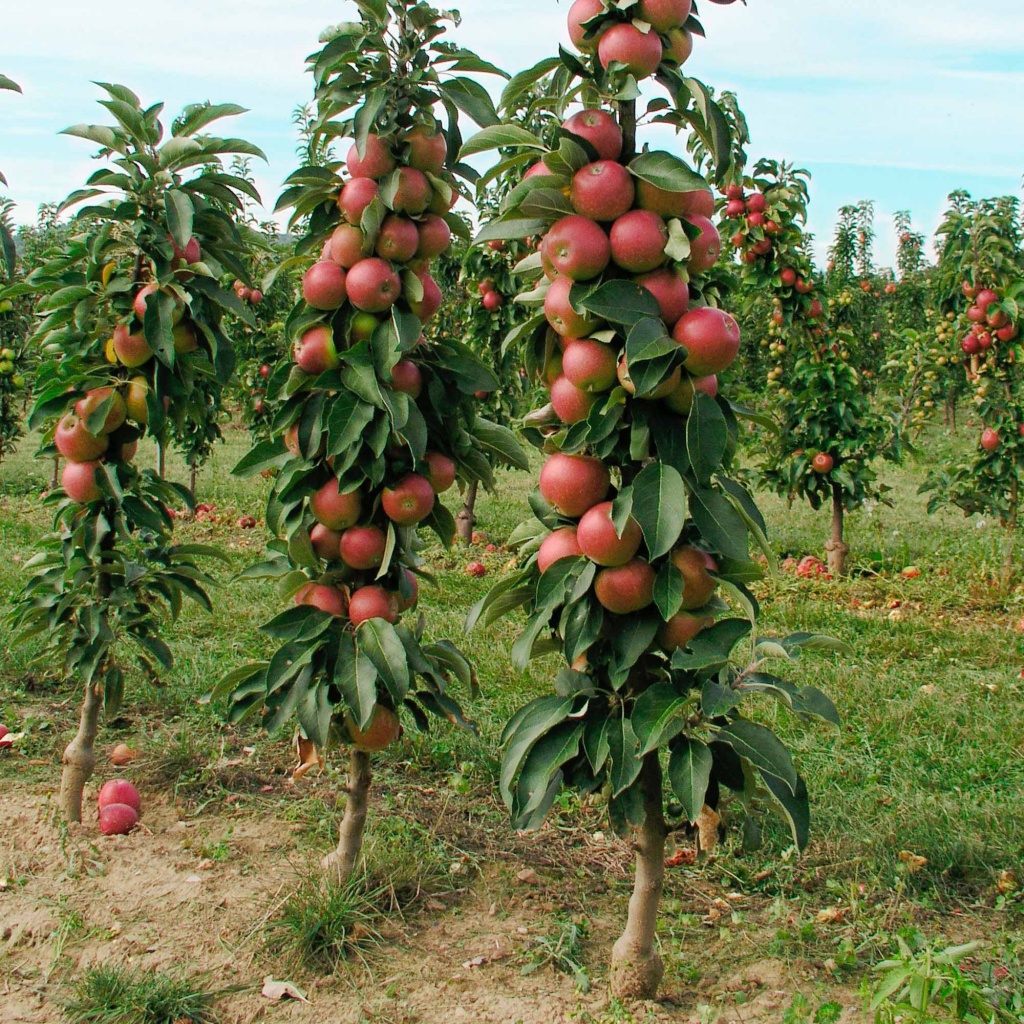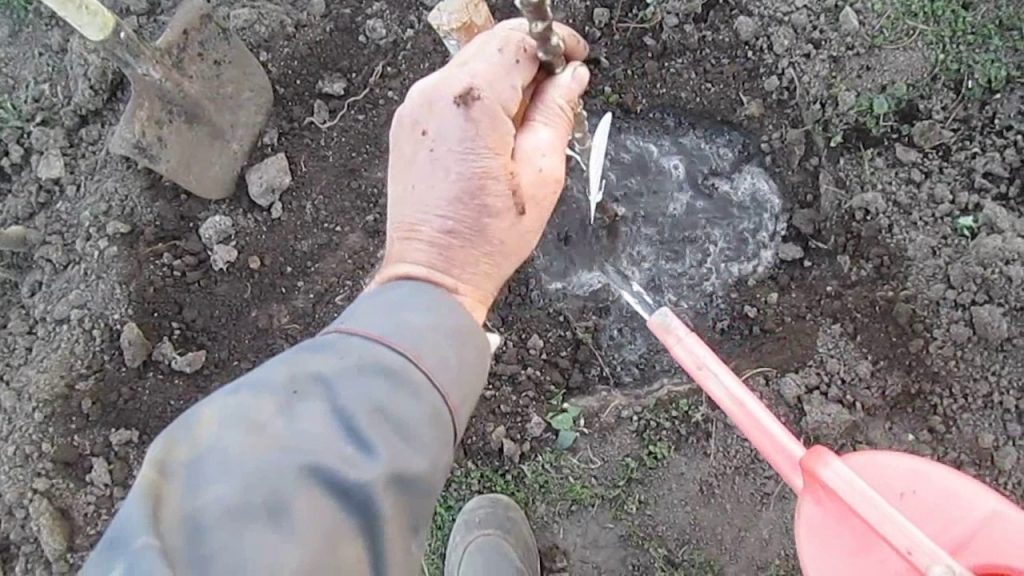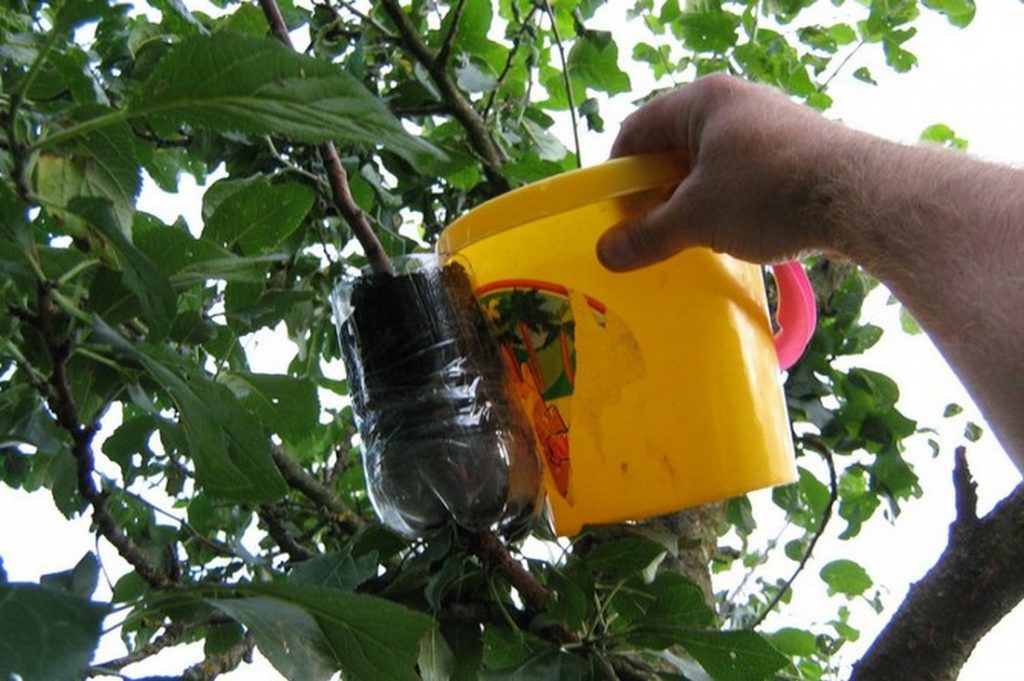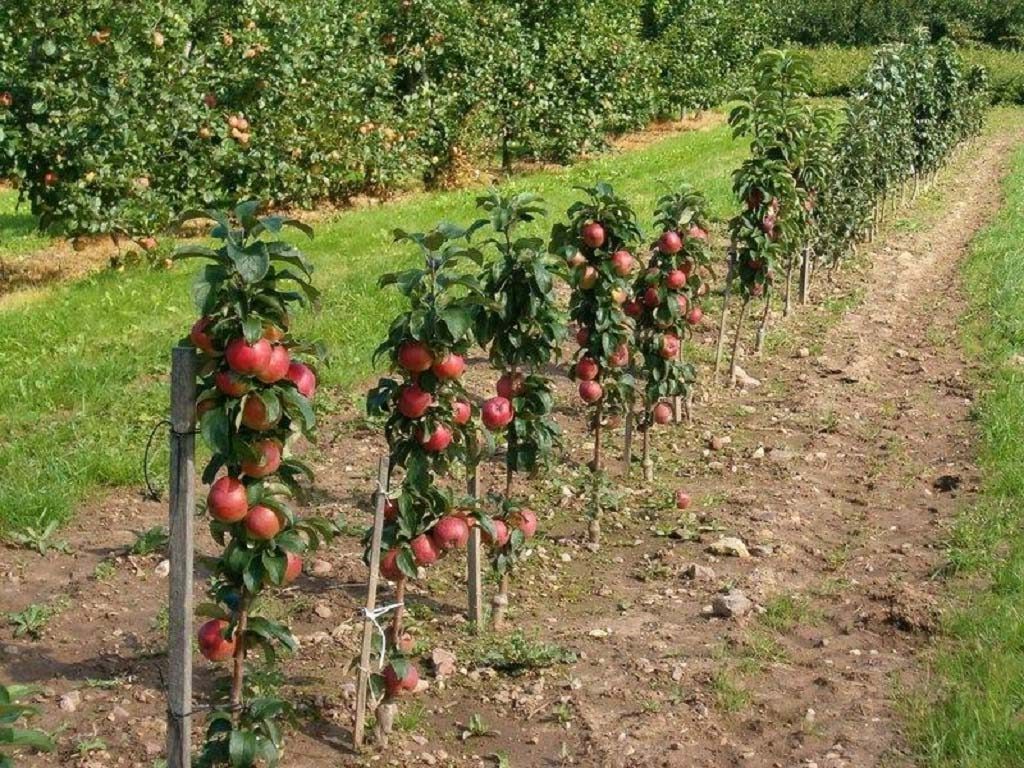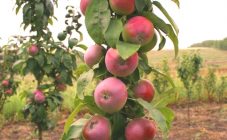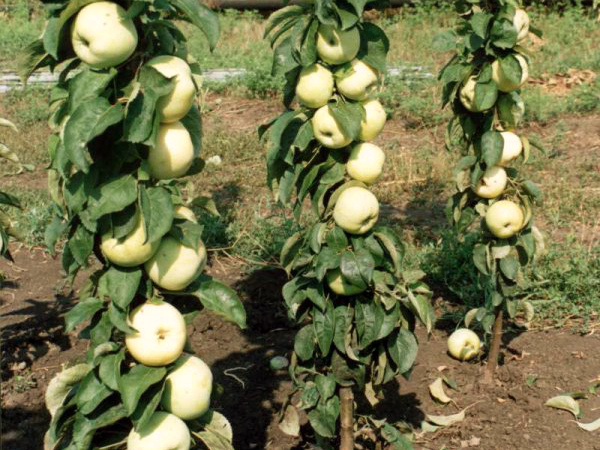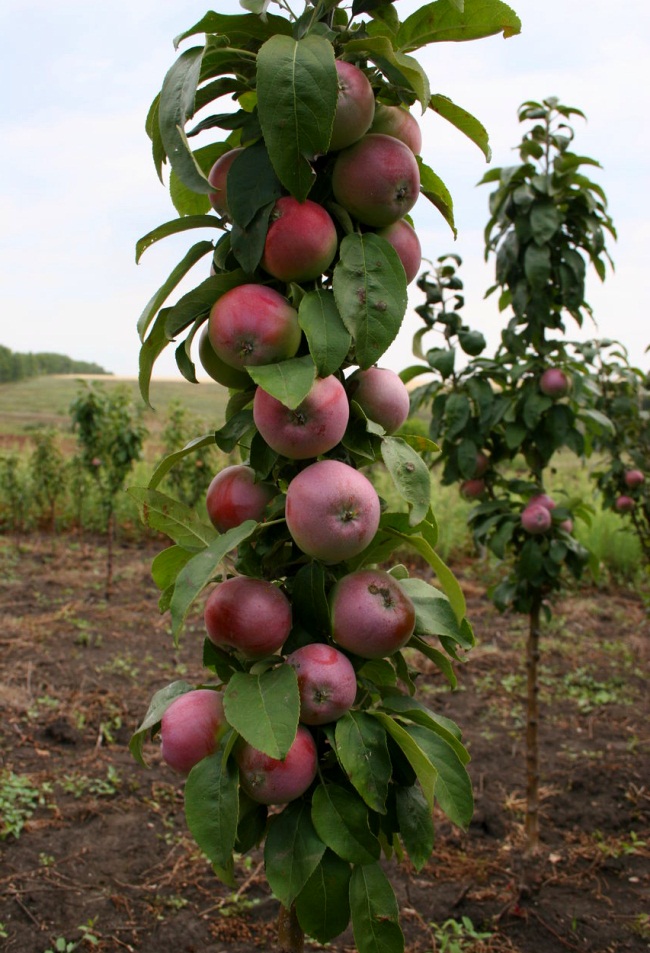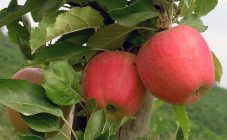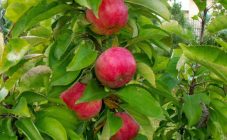Content:
It is difficult to imagine a fruit garden without apple trees of different varieties - summer, autumn, winter. However, these fruit trees have a large spreading crown, so it is hardly possible to grow as many apple trees of different varieties as we would like on six acres. However, breeders have bred a new type of this fruit crop - columnar (or pyramidal) apple trees. Below we will talk about all the advantages of these trees, which can be perfectly grown up to 10-15 pieces even in a small garden.
Columnar, pyramidal and cone-shaped apple trees: what is the difference
For the first time they started talking about these apple trees in the middle of the last century. This is one of the few fruit trees that was born as a result of mutation (or, as local breeders said, a kind of joke of nature). One of the Canadian farmers noticed that on one of the apple trees growing in his garden, a branch has grown on which there are no side shoots, and the shoot itself is densely covered with fruits. Cuttings from this branch (grown on a Macintosh apple tree) were planted by this gardener on the stocks of other apple trees. The result is a new, stable and compact apple tree species.
The pyramidal (or columnar) apple tree attracted the interest of breeders from around the world, as a result of their labors, many new varieties of such fruit trees have appeared, which are currently very popular with gardeners around the world.
The crown shape of such fruit crops can be pyramidal, cone-shaped or columnar (depending on the specific variety). And all the differences between them depend on the specific characteristics of the respective varieties, starting with the shape of the crown and ending with the yield, size and color of the fruits. But the main thing for all these fruit trees is their compactness, thanks to which many trees can be grown even in a small garden area in order to get a large harvest of apples from them.
Features of the columnar apple tree
Many gardeners, flattered by the compactness and relatively high yield of such fruit trees, tried to plant a large number of such seedlings, but did not know about all the nuances of planting and further care for such plants. As a result, problems arose:
- the promised harvests were not received;
- apples are too small, they taste like wildfruit;
- in the aerial part, the crown is formed like that of an ordinary variety, and not in the form of a column.
Experts note that this is possible if the main agrotechnical measures are not followed in the process of planting a columnar apple tree and further care for it. Such procedures differ from similar ones when growing ordinary varieties of apple trees, but not all gardeners know about this, and therefore they are disappointed when they do not get the expected result from a new species, so they decide to immediately remove such trees from the site.
However, not all is lost, and if you take proper care of this crop in the future, the tree can restore the correct shape and improve yield. The main thing is to observe the schedule of fertilizing and watering in the process of leaving, as well as to correctly carry out the procedure for cutting and forming ovaries.
Characteristics of varieties of columnar apple
All varieties of columnar apple trees are subdivided by trunk height into:
- vigorous;
- semi-dwarf (medium-sized);
- dwarf.
Also, these varieties are distinguished by the ripening time:
- early (summer);
- mid-season (autumn);
- late ripening (winter).
The main characteristics of summer varieties:
- harvesting period from the last decade of July to the first decade of September;
- high productivity;
- the average weight of apples is about 150-200 g;
- good taste of ripe fruits;
- high resistance to frost and pest attacks.
Summer varieties that are zoned for cultivation in many regions of Russia:
- Nectar;
- The president;
- Vasyugan;
- Dialog;
- Ostankino.
The main qualities of autumn varieties:
- ripening of the crop during all autumn months;
- shelf life of ripe fruits until early January:
- the collected fruits are universal in use;
- the mass of ripe apples can reach 250 g;
- the yield is not less than average for such varieties of apple trees.
Main varieties:
- Gin;
- Triumph;
- Arbat;
- Iezen.
The following qualities are characteristic of winter varieties:
- ripening period from mid-autumn to November;
- the harvested crop can be stored until April;
- trees are distinguished by high resistance to frost and diseases;
- good taste of fruits;
- perfectly tolerate transportation.
Most popular varieties:
- Currency;
- Moscow Necklace;
- Amber;
- Bolero;
- Yesenia.
Columnar apple tree: planting and care
You can plant these trees in open ground both in spring and autumn, but no later than the end of September. Planting holes are prepared in the fall, if they are going to be planted in the spring, and in the spring, if they are planted in the fall.
The seedling area should be well lit and protected from gusts of cold winds.
A step-by-step guide to planting columnar apple trees in spring:
- In the fall, a pit is prepared with a diameter of 1 m and the same depth.
- A layer of drainage material (gravel or river sand) with a thickness of at least 5-7 cm is laid on the bottom.
- The next layer is fertile garden soil (the top layer of soil, selected from a dug hole), to which 30 kg of humus are added, one glass of potash and phosphorus fertilizers each.
- From this layer, a mound is formed in the center of the pit, on which a young tree is set.
- The roots are spread along the slopes of the hill, the remaining soil is poured on top and tamped.
- The root collar should be 4-5 cm above the soil surface.
- At least 20 liters of water are poured under each tree.
- From above, the soil is mulched.
If the trees are planted in the fall, the planting instructions will be similar. The only requirement is that the landing time should be calculated so that at least 2 months remain before the onset of cold weather.
Planting a columnar apple tree in the spring in the Moscow region
Planting such varieties of apple trees in the Moscow region in the spring is no different from a similar planting in other regions. The only thing that can change is the specific month of spring in which such a procedure will be carried out.The land should warm up before planting, so sometimes gardeners plant trees in May.
Rules for caring for varieties of columnar apple
When growing this fruit crop, certain rules of care should be observed, the further development of trees and their fruiting depends on their correct observance.
Caring for columnar apple trees includes:
- compliance with the irrigation regime;
- feeding.
For the first time, trees are fertilized immediately after the young foliage begins to appear. The next feeding is carried out at intervals of 12-14 days (after the previous one). In total, trees are fed 4 times per season.
They need to be fed with the following solution: for 10 liters of water, 1 shovel of manure and 1 tbsp. spoon of urea.
These trees do not require special pruning. Only the central trunk grows well in them, and the side branches grow if the top has been damaged. In this case, of all lateral shoots, the longest is left intact, and the rest are removed.
Reproduction of a columnar apple tree
Typically, this variety of apple trees is propagated by grafting cuttings onto suitable rootstocks. However, if the gardener does not have such experience, then it is better to seek help from a specialist.
Some plant seed. But this method is too long in time, and the grown seedlings do not always receive all the characteristics of the parent tree.
The third way of reproduction is by air layers. A finger-thick shoot is chosen from the tree, an incision up to 5 mm wide is made near its base, wrapped with cotton wool, which is soaked in heteroauxin, for 24 hours. Then a belt of wet peat is made around the incision, which is wrapped on top with a layer of polyethylene so that there is no air access.
If a similar procedure is carried out in the spring, then by the beginning of the autumn period, roots are formed under the peat. The shoots together with the roots are separated from the main trunk and transplanted to a previously prepared place.
Taking care of these apple trees, in general, is not too difficult. It is necessary to correctly carry out the procedure for planting seedlings, and then water and feed on time. It should be remembered that the roots of the columnar apple tree are close to the soil surface, therefore, the near-trunk circle should not be overfilled, otherwise the roots may begin to rot. It is also required to carefully process the soil near the main trunk so as not to damage the root system. Nothing complicated, so even a novice gardener can grow a columnar apple tree.
